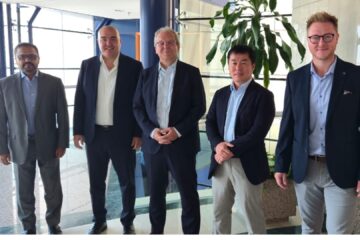Building AI-native solutions for the future

Sharif Berdi, Senior Director - Data & AI Engineering, Inception (a G42 company)
Inception, part of the G42 ecosystem, has quickly emerged as one of the UAE’s leading forces in applied AI innovation, transforming from a research-driven institute into a commercial AI solutions powerhouse. In this conversation with CXO DX, Sharif Berdi, Senior Director – Data & AI Engineering, Inception (a G42 company), discusses the company’s evolution, its agentic AI focus, and how it’s driving sovereign, responsible AI transformation across government and enterprise sectors.
Tell us about the company’s areas of focus.
Inception has actually been around for about five years, though it was initially more of a research institute. We worked closely with universities and research scientists, focusing on advanced AI research and development. About a year ago, we transitioned into a commercial AI product organization, becoming the entity now known as Inception.
We remain part of the G42 Group, but our focus is squarely on building AI-native solutions for the enterprise and government sectors. Our solutions cover multiple domains, everything from corporate and enterprise functions such as procurement, HR, and IT, to specialized workflow-driven automation systems where we layer AI to enhance efficiency and decision-making.
We also develop domain-specific AI solutions. For instance, we’re helping executives and boards improve strategic decision-making through AI assistants that can summarize insights and recommend actions. We have AI-driven investment tools that support investment committees in evaluating opportunities, and we’re applying AI for the energy sector, including oil and gas operations, using AI to automate subsurface data analysis and operational processes.
In essence, our goal is to bring AI-native, agentic solutions that can integrate deeply with existing systems across industries, amplifying human expertise and transforming traditional workflows.
How are you approaching Agentic AI deployments?
Agentic AI for us is about integrating intelligent agents directly into enterprise workflows, whether that’s HR, finance, procurement, or government operations. These agents act as co-pilots within those systems, able to reason, take actions, and generate outcomes autonomously.
It’s not limited to back-office tasks either. We’re also developing AI assistants for executives, for example, helping with board meetings, decision preparation, and strategic recommendations. We even see potential in media applications, where agents can assist with content, scheduling, and insight generation.
In short, while generative AI focuses on creating content, agentic AI represents the next evolution — intelligent, autonomous systems embedded within workflows that can act, decide, and deliver tangible outcomes.
How does Inception align with the UAE’s vision for sovereign AI?
We’re actually at the center of that mission. We work closely with multiple government entities that are undergoing rapid digital and AI transformation.
Every solution we build, from infrastructure to application level, is designed around sovereignty, localization, and responsible AI principles. We ensure full compliance with UAE data governance requirements, apply guardrails and responsible AI frameworks, and deliver end-to-end solutions that are locally hosted and controlled.
In short, sovereignty isn’t just a layer for us; it’s built into our foundation, from data handling and infrastructure to deployment and user experience.
What products and solutions did you showcase at GITEX this year?
At GITEX Global 2025, we showcased around 70–80 AI products, covering multiple sectors and use cases.
Our main objective was to demonstrate authentic intelligence in action , not just models or chat interfaces, but real enterprise-grade agents that deliver measurable results. We’re not merely running RAG (retrieval-augmented generation) or embedding open models; we’re building and deploying real AI agents that can augment human capabilities across complex enterprise workflows.
That’s what sets us apart; we have a strong research and development backbone, and we’re now applying that directly into enterprise-grade applications.
Can you tell us about your R&D capabilities and how they’ve evolved?
Our R&D team has grown significantly; we’re now about 150 to 160 people, up from around 80 a year ago. That’s nearly double in just twelve months.
We’re still a lean but powerful team, and we’re proud of how much we’ve built in such a short time. Despite our relatively small commercial footprint, the number of products and solutions we’ve developed in one year speaks volumes about our agility. We move fast, iterate fast, and scale rapidly, and that’s a key part of our DNA.
How does Inception ensure data compliance and model security when deploying AI solutions?
We take compliance and governance very seriously. From a technical standpoint, we’ve developed evaluation models and guardrails that continuously assess compliance, security, and ethical alignment.
We also use our own pre-trained models to evaluate and constrain AI behavior, applying these through structured frameworks and policies. This ensures that every agent or model we deploy meets the highest standards of data protection and regulatory alignment, particularly within sensitive government and enterprise environments.
How do generative and agentic AI complement each other in real-world deployments?
They’re closely related but serve different purposes. Generative AI focuses on creating such as generating text, visuals, or structured outputs. Agentic AI, on the other hand, takes this further and acts on the generated insights.
So while generative AI can produce recommendations, agentic AI can execute them, completing actions, managing workflows, and interacting across systems. In most enterprise use cases, the two coexist: generative AI for creativity and synthesis, and agentic AI for automation and action.
Where is most of the demand coming from today?
Demand is broad because we’re industry-agnostic. We serve both government and enterprise sectors, but we prioritize areas where autonomous, AI-native solutions can drive the most value in high-volume, workflow-intensive environments like HR, procurement, finance, and executive support.
Wherever there’s a need for intelligent autonomy and decision augmentation, that’s where we focus.
How do you collaborate within the wider G42 ecosystem?
We collaborate closely with several G42 entities while maintaining our distinct focus. Each company within the ecosystem plays a specific role in the AI stack, from infrastructure and data centers to models and industry applications.
For example, Presight focuses on data analytics, Cybex on cybersecurity, and other subsidiaries specialize in their respective domains. At Inception, we focus on the foundational AI layer and enterprise applications, helping integrate and operationalize AI across sectors.
Together, we ensure that G42’s Intelligence Grid, spanning infrastructure, intelligence, and innovation, operates as one cohesive ecosystem delivering full-stack AI solutions to enterprises and governments.















